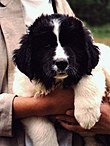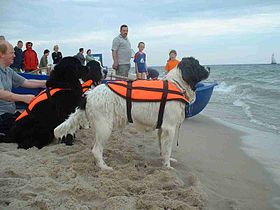Landseer (dog breed)
| Landseer (European-continental type) |
||
|---|---|---|
|
|
||
| FCI Standard No. 226 | ||
|
||
| Origin : | ||
| Withers height: |
Male 72–80 cm. |
|
| Weight: |
Male 60–75 kg, |
|
| List of domestic dogs | ||
The Landseer is a dog breed recognized by the Fédération Cynologique Internationale (FCI) , the origin of which is in Germany and Switzerland. The breed is led by the FCI with the standard No. 226 in group 2, section 2.2 .
Origin and history

The Landseer as an independent breed is comparatively young. The breed emerged against the background that the white and black type of the Newfoundland was pushed back more and more in England at the beginning of the 20th century and threatened to disappear. Swiss and German cynologists began to build up their own breed based on white and black Newfoundland dogs from England, which they called Landseer - in accordance with the name that was already widespread for this Newfoundland color . In 1960 the Fédération Cynologique Internationale recognized the Landseer as an independent breed.
The name of the breed is based on the fact that the painter Edwin Landseer , one of the most famous English animal painters of his time, preferred white and black dogs in his paintings and drawings around the mid-19th century, which in Great Britain under the name Newfoundland Dog , Newfoundland, were known. The painter's preference led to the fact that this dog soon got the common name Landseer Dog , without the official breed name changing.
The immediately identifiable origin of the breed are dogs brought to England by British fishermen from Newfoundland . It can be assumed that the origin of these dogs was in Europe, as Basque whalers overwintered in the northern part of Newfoundland long before the British. As it was customary to carry dogs on ships, it is likely that these Basques were accompanied by large northern Spanish dogs that were often left behind in the spring. The visual similarities with the great Spanish Pyrenean dog Mastín del Pirineo are partly obvious. It is possible that the Newfoundland, today's Landseer and Pyrenean Mountain Dogs Chien de Montagne des Pyrénées have common ancestors.
In Great Britain, as Newfoundland Dogs , the dogs became popular dogs of the English nobility and the upper classes, with which one liked to adorn oneself. Edwin Landseer's drawings further increased their popularity.
In 1886 the "Newfoundland Club" was founded in England, which bred both the original white and black and the black and red and brown types that had appeared since around 1850. The dispute over a standard between the supporters of the black and the supporters of the white and black spotted dogs began early on . The advocates of the black type prevailed and efforts were made to merge both types, over which the original white-black type appeared less and less and was almost forgotten in England. The renaissance of the white and black Landseer began at the beginning of the twentieth century, when Swiss and German cynologists and breeders brought the last of the animals that could still be used for breeding from England and established the continental European pure breeding of the Landseer. Due to the dominant inheritance of the black coat color, Kuvasz and Pyrenean Mountain Dogs were crossed as homozygous white breeds in order to consolidate the original white-black character .
Today the two breeds, Landseer and Newfoundland, which emerged from the Newfoundland Dogs, differ significantly. The Landseer's head does not seem so massive, the snout is a little longer and not so blunt. Overall, it is slightly larger and looks more agile than the Newfoundland dog. The black and white Newfoundland dog did not disappear, it continues to exist alongside the newly created Landseer breed .
description
The Landseer is a large dog with an imposing shape and can grow up to 80 cm or sometimes even larger. The triangular ears are medium in size and when placed against the eyes they reach the inner corner of the eye. The top coat is interspersed with an undercoat. The white base color with black plates, which are distributed on the torso and the croup area, is striking. The head is black, a not too wide symmetrical white blaze and a white snout are considered as breeding . The legs, chest, neck, tail and belly must be white.
Essence and use
The Landseer is described as more alert, active, and spirited than the Newfoundland dog. He has a natural watchful and protective instinct and is very people-oriented. As the legacy of his Spanish ancestors, who defended their herds against wolves and bears for centuries, a Landseer independently recognizes dangers and is able to instinctively make independent decisions to ward off them. It has had a reputation for saving people from drowning on its own since the 19th century, which is why it is still used today as a water rescue dog on lakes and on the coasts. The Landseer is also increasingly used as a therapy dog , as it is generally very eager to learn and usually has a high stimulus threshold for people .
Bred up accordingly, the Landseer is a very suitable family dog . Therefore, keeping a Landseer requires a loving, but always consistent upbringing, which should start as early as possible. In order to develop its many positive qualities, however, the Landseer needs close contact with his family. It is therefore not suitable for keeping in a kennel. A house with a fenced-in area where the dog can move freely is ideal for keeping a Landseer. He is an attentive companion dog on walks. In addition, he is a pleasant and regularly calm house dog who barks for a reason. He is friendly to guests of the house; He is vigilant and reserved towards strangers.
literature
- Victor Goerttler: Newfoundlanders and Landseers (= Die Neue Brehm-Bücherei. Volume 371). 5th, extended edition, Westarp-Wissenschaften, Hohenwarsleben 2006, ISBN 3-89432-769-3 (reprint of the 1st edition Ziemsen, Wittenberg 1981).
Web links
- Breed standard No. 226 of the FCI: Landseer (PDF)
- German Landseer Club
- Association of Landseer friends and breeders in Germany
- General German Club for Newfoundland dogs
- Landseer Association Switzerland
Individual evidence
- ↑ Hans Räber : Encyclopedia of the pedigree dogs. Origin, history, breeding goals, suitability and use. Volume 1: Farmers, shepherds and cattle dogs, shepherds, mastiff-like dogs, pinscher-like dogs, spitz-like dogs, Nordic dogs, Schensi dogs, dwarf dogs, poodles, Dalmatians. Franckh-Kosmos, Stuttgart 1993, ISBN 3-440-06555-3 , p. 191.


